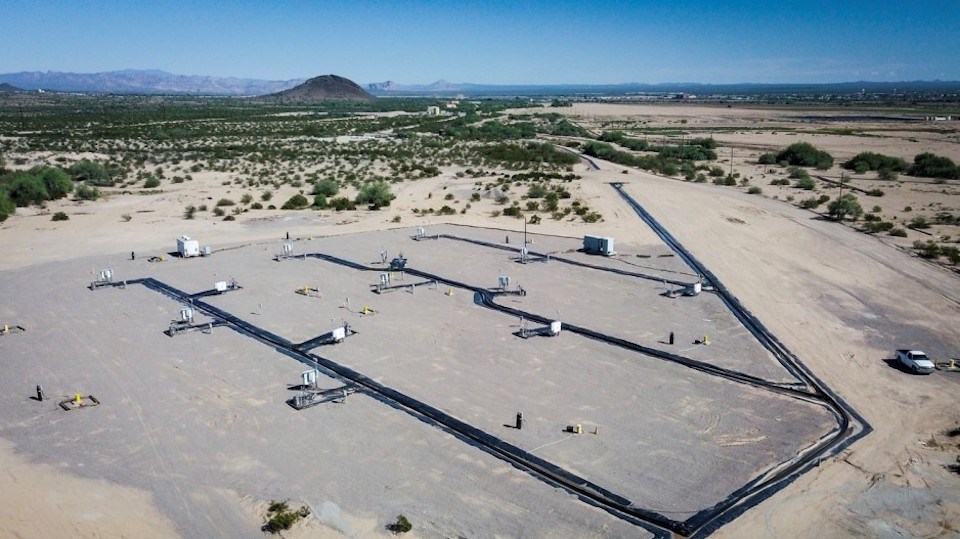Taseko Mines (TSX:TKO, NYSE:TGB) reported record revenues for the third quarter at its Gibraltar copper mine in B.C., thanks to higher copper grades and high copper prices, and is now laser-focused on developing a new copper project – but not in B.C.
As the prospect of building its New Prosperity copper mine in B.C. has all but evaporated, the company has turned its focus to Arizona, where it is planning to build a new in situ copper project. Also in its development pipeline is the Yellowhead copper mine proposal northeast of Kamloops which, if built, would be on par with the Gibraltar mine in terms of production potential.
Taseko plans to spend US$230 million to develop the Florence copper project in Arizona. That’s on top of the US$80 million already spent bringing the project through the permitting process.
“We think we’re going to get permitted and start construction next year,” said Taseko CEO Stuart McDonald in an earnings call in November. “We do have other projects in the pipeline. We’ve got potential at Gibraltar to expand the mine life … and of course Yellowhead coming in the future too.
“So we’ve got other projects in the pipeline, but really we’re confident that Florence is going to be the next mine for Taseko.”
The next big mine project for Taseko was supposed to be the New Prosperity mine in B.C. – said to among the top 10 richest undeveloped copper deposits in the world. But it appears to have been kicked to the bottom of Taseko’s project pipeline. In its most recent earnings call with analysts, company executives didn’t mention it and no one asked about it.
There’s good reason for that. It has been vigorously opposed by the Tsilhqot’in First Nation, and has been rejected twice by the federal government. And on Friday, January 14, a provincial environmental certificate will expire.
Two years ago, when the Tsilhqot’in made the surprising decision to agree to a legal standstill over the troubled New Prosperity copper mine project and support an extension to the provincial environmental certificate, it raised the possibility that the project – which the Tsilhqot’in had formally pronounced dead -- might not be quite dead after all, but on life support.
But last week, B.C. Environment Minister George Heyman decided it was time to pull the plug.
If Taseko ever manages to get the Tsilhqot’in on board with the Prosperity project, it would have to go back to the drawing board and start all over again with both federal and provincial environmental review processes.
Taseko was twice denied a federal environmental certificate to build the Prosperity (and rebranded New Prosperity) copper mine. But the project did at least have a provincial environmental certificate, something that allowed Taseko to keep the project legally in play through a number of court challenges.
As of January 14, it won’t even have that, as the certificate will have finally expired.
Environmental certificates require substantial work to begin by certain deadlines, or the certificate expires. In the Prosperity mine’s case, the B.C. government had already granted three extensions.
In December 2019, Taseko and the Tsilquot’in agreed to hold their respective legal activities over the mine in abeyance and try to talk things out.
Part of the standstill agreement included the Tsilhqot’in’s support of an application for a one-year extension to the provincial environmental certificate, which was to expire in 2020. The extension was granted.
The standstill agreement remains in place, and Taseko applied in early December for yet another one-year extension to the environmental certificate. But on December 21, Heyman rejected the application.
Heyman notes in his letter to Taseko and the Tsilhqot’in that environmental certificates are typically granted only one extension, whereas the Prosperity project has already been granted three since 2015.
Moreover, he notes that an extension would not mean the mine could be built in any case, given that the federal government has twice declined to approve it.
“At this time, the certificate is almost 12 years old, and does not… authorize a project that will be built … given the federal rejection of New Prosperity,” Heyman writes.
“In my view, rather than extending a certificate that followed an assessment conducted more than a decade ago, it would be appropriate for Taseko to apply, if it wishes to do so, for a new certificate in respect of a project that it does intend to build.”
The market greeted Heyman’s decision with indifference, with Taseko’s shares rising slightly following the December 23 decision.
The Prosperity mine saga underscores the reality that, in B.C., a new mine cannot be built without First Nations consent and support. Taseko’s Yellowhead project may prove more feasible, as the company has secured an early stage agreement with the Simpcw First Nation to explore its potential development. That mine project has an estimated capital cost of $1.3 billion.
“We are working with them towards initiating the EA process,” said Sean Magee, vice-president of corporate affairs for Taseko told BIV.
The company’s main focus for now is bringing the Florence Copper project in Arizona into production, using a novel in situ process – an alternative to conventional underground or open-pit mining that has a very low capital cost.
It’s a process that is only conducive to certain types of deposits, and is more like conventional oil well drilling than mining. Wells are drilled and then oxide copper is dissolved underground and the copper brought to the surface for processing.
The company expects the Florence mine could produce 85 million pounds of copper annually. By contrast, Gibraltar produces about 130 million pounds annually.
“It will operate for 20 years at extremely low cost,” said Magee. “So it’s a pretty significant increase in our productivity and our profitability.”
As for the Prosperity project, Magee said the company and the Tsilhqot’in are still at least talking.
“As long as those talks are productive and constructive towards a mutually acceptable resolution, that’s where our focus will be,” he said.



